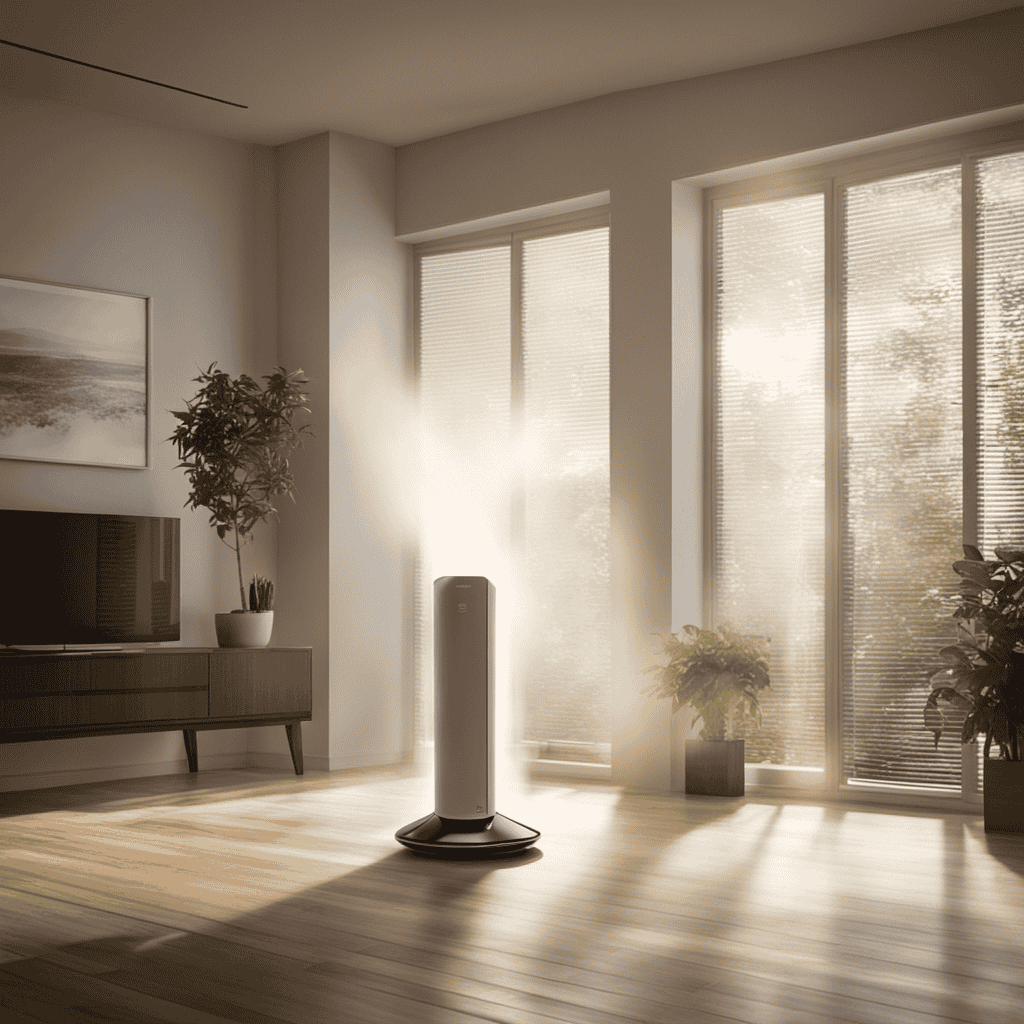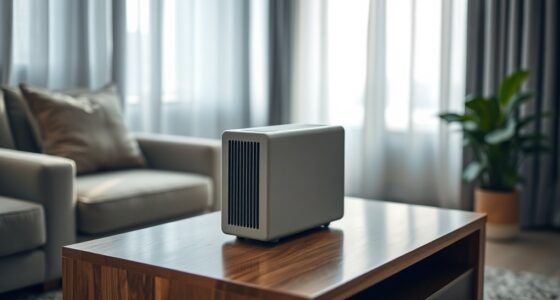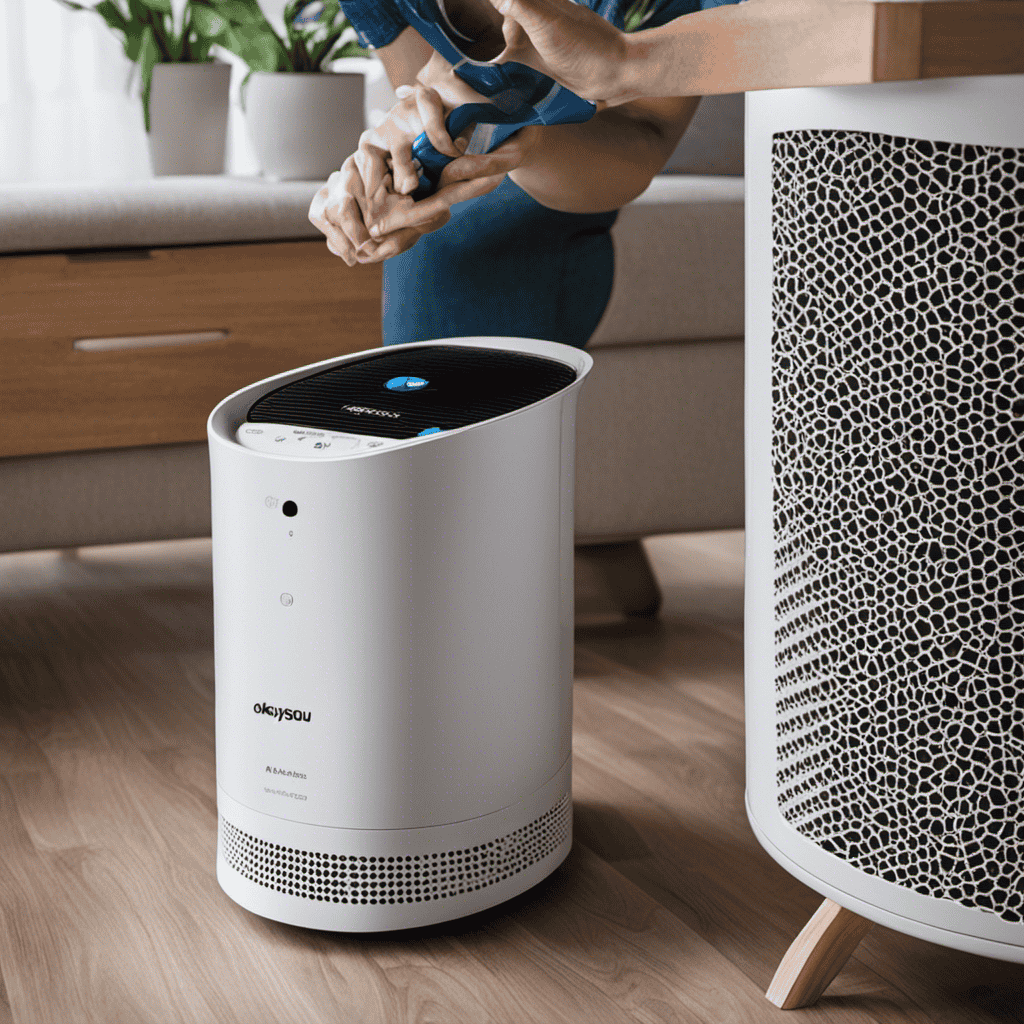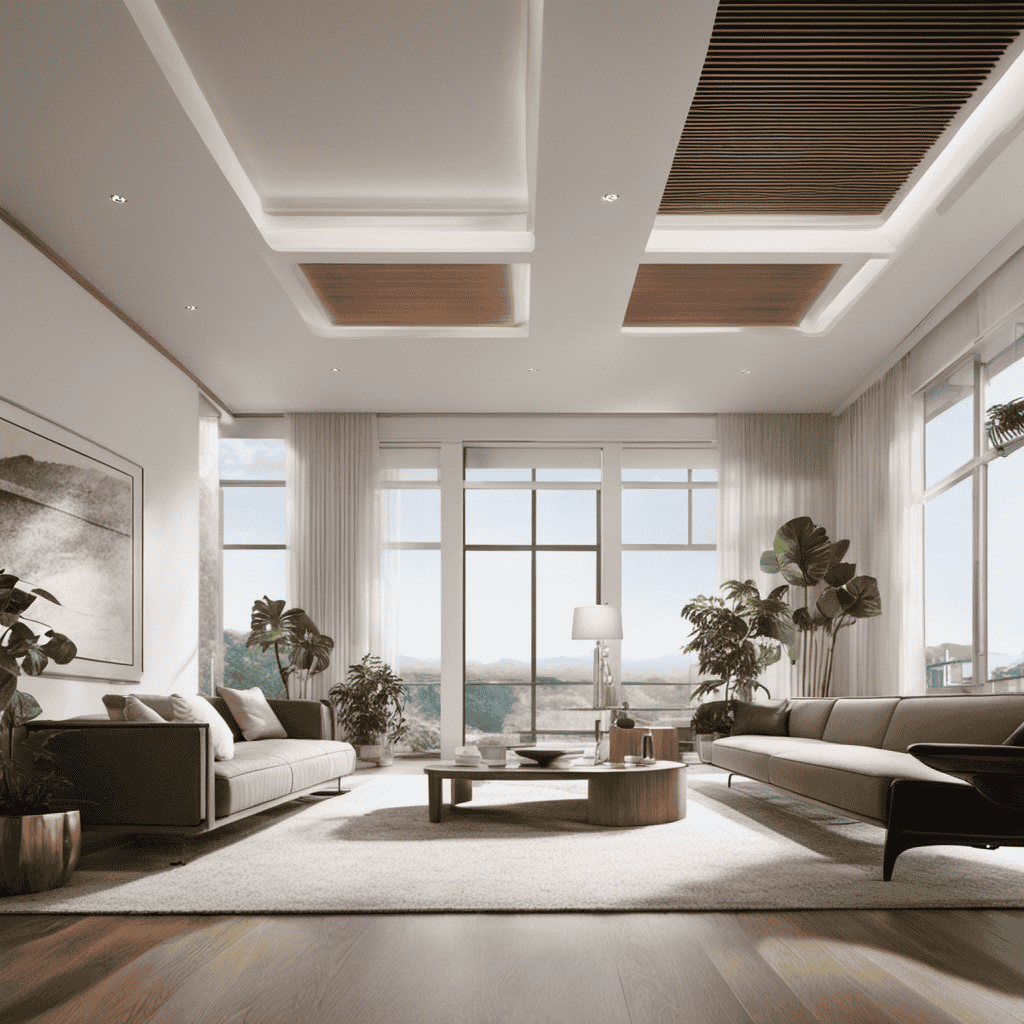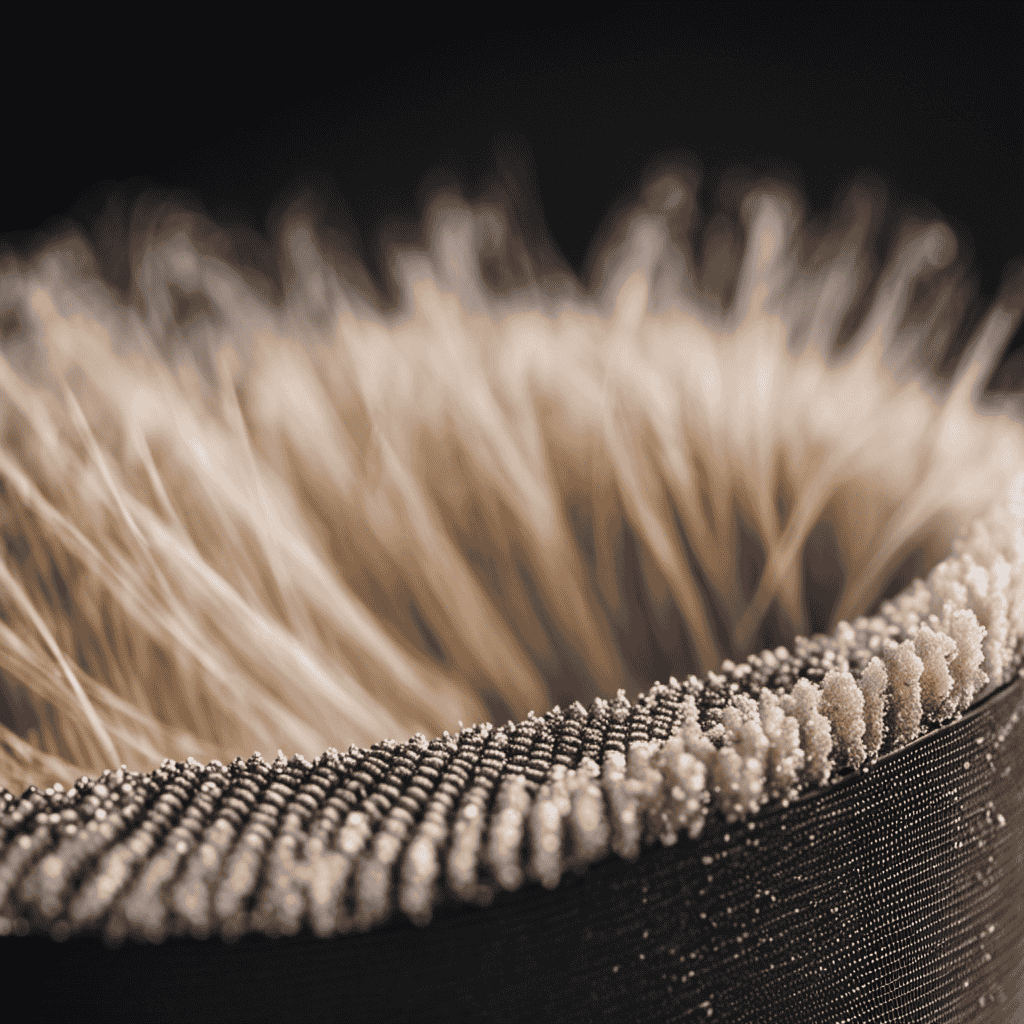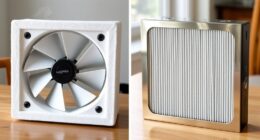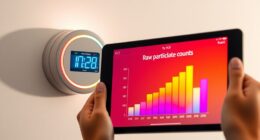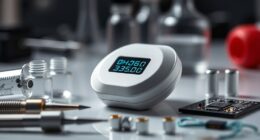I’ll tell you, people, air purifiers are a game-changer when it comes to cleaning the air in your small room. But have you ever wondered just how long it takes for these handy devices to do their job? Well, wonder no more because I’ve got all the details for you.
In this article, I’ll break down the factors that affect air purifier cleaning time, give you the recommended cleaning time for small rooms, and explain how these purifiers actually work.
So, let’s dive in and clear the air on this topic!
Key Takeaways
- The size of the room, level of air pollution, layout, and obstacles affect the cleaning time and efficiency of an air purifier.
- Running the purifier for at least two hours is recommended for small rooms, as it allows for continuous air cycling and removes pollutants like dust, pollen, and pet dander.
- Air purifiers work through filtration, activated carbon filters, ionization technology, and UV-C light to effectively reduce indoor air pollution.
- Factors such as CADR ratings, filter type, fan speed, room size, and pollutant concentration should be considered for optimizing air purifier efficiency in small rooms.
Factors Affecting Air Purifier Cleaning Time
There are several factors that can affect how long it takes an air purifier to clean a small room.
The purification speed of an air purifier can be influenced by various factors. One important factor is the size of the room. Larger rooms may take longer to clean compared to smaller ones as there is more air to purify.
Another factor that can impact purification speed is the level of air pollution in the room. If the room has high levels of pollutants like dust or allergens, the air purifier may take longer to clean the air effectively.
Additionally, the layout of the room can also affect the efficiency of the air purifier. If there are obstacles or barriers that block the airflow, the purifier may take longer to circulate and clean the air.
Therefore, it is essential to consider these factors when determining the time it takes for an air purifier to clean a small room.
Recommended Cleaning Time for Small Rooms
To ensure optimal results, it’s recommended to run the purifier for at least two hours in a small room. The recommended cleaning time is based on scientific evidence that shows it takes time for an air purifier to effectively clean the air in a room.
By running the purifier for at least two hours, you allow it to continuously cycle the air and remove pollutants such as dust, pollen, and pet dander. This extended cleaning time ensures that the air in the room is thoroughly purified, creating a healthier and more comfortable environment.
The benefits of air purification are numerous, including improved indoor air quality, reduced allergies and asthma symptoms, and a decrease in respiratory issues. By following the recommended cleaning time, you can enjoy these benefits and breathe cleaner air in your small room.
How Air Purifiers Work in Cleaning Indoor Air
Air purifiers use filters to trap and remove pollutants from the air, improving indoor air quality. These filters are designed to capture a wide range of contaminants, including dust, pet dander, pollen, mold spores, and even harmful gases and odors.
Here’s how air purifier technology works to clean indoor air:
-
Filtration: Air purifiers typically have a pre-filter that captures larger particles, followed by a high-efficiency particulate air (HEPA) filter that removes smaller particles as small as 0.3 microns.
-
Activated Carbon: Some air purifiers also feature activated carbon filters, which are effective at absorbing odors, gases, and volatile organic compounds (VOCs).
-
Ionization: Certain air purifiers use ionization technology to charge particles in the air, causing them to stick to surfaces or be attracted to oppositely charged plates.
-
UV-C Light: A few air purifiers incorporate ultraviolet germicidal irradiation (UVGI) technology, which uses UV-C light to neutralize and kill bacteria, viruses, and mold spores.
Overall, air purifiers provide an effective solution for reducing indoor air pollution and creating a healthier living environment.
Understanding Clean Air Delivery Rate (CADR
When it comes to choosing an air purifier, understanding the Clean Air Delivery Rate (CADR) is crucial. The CADR indicates the amount of clean air the purifier can deliver in a specific time period.
However, it’s important to consider the size of the room as well, as CADR ratings are typically given for specific room sizes.
Additionally, there are several factors that can affect the CADR of an air purifier. These factors include the type of filter used, the fan speed, and the level of pollutants in the air.
CADR and Room Size
The CADR rating of an air purifier determines its effectiveness in cleaning a small room. It’s essential to consider the CADR when choosing an air purifier, as it directly correlates to the efficiency of removing pollutants from the air.
Here are some key factors to keep in mind regarding CADR and room size:
-
CADR and Filter Replacement: A higher CADR means the air purifier can remove a larger volume of pollutants. However, it’s important to note that higher CADR ratings may require more frequent filter replacements.
-
Noise Level: Air purifiers with higher CADR ratings tend to have more powerful fans, which can result in increased noise levels. Consider the noise level tolerance of the room where the purifier will be placed.
-
Energy Consumption: Air purifiers with higher CADR ratings may consume more energy. Be mindful of energy efficiency and choose a model that balances CADR performance with energy consumption.
-
Room Size Consideration: The CADR rating of an air purifier should match the room size to ensure optimal performance. Refer to the manufacturer’s guidelines for recommended CADR ratings based on room dimensions.
Factors Affecting Cadr?
In order to understand the factors affecting the effectiveness of air purifiers, it is important to consider the impact of air quality on the Clean Air Delivery Rate (CADR). CADR refers to the rate at which an air purifier can remove pollutants from the air. The CADR is influenced by various factors, including the size of the room, the type of pollutants present, and the airflow rate of the purifier.
Firstly, the size of the room plays a crucial role in determining the CADR. Larger rooms require purifiers with higher CADR values to effectively clean the air.
Secondly, the type and concentration of pollutants in the room also affect the CADR. For example, purifiers may be more effective at removing particulate matter compared to volatile organic compounds.
Lastly, the airflow rate of the purifier determines how quickly it can circulate and clean the air.
Therefore, when considering the effectiveness of air purifiers, it is essential to take into account these factors, as they directly impact the CADR and overall air purifier performance.
Tips to Optimize Air Purifier Efficiency in Small Rooms
To optimize your air purifier’s efficiency in small rooms, try placing it in the center of the room. This ensures that the clean air is evenly distributed throughout the space, maximizing its effectiveness.
Additionally, consider the following tips:
-
Proper sizing: Choose an air purifier that is suitable for the size of your room. A unit that is too small may struggle to clean the air effectively, while one that is too large may consume unnecessary energy.
-
Energy-saving features: Look for air purifiers with energy-saving modes or timers that allow you to control the device’s operation and reduce energy consumption.
-
Noise level: Consider the noise level of the air purifier, especially if you plan to use it in a bedroom or office. Look for models that have a low noise output to ensure a peaceful environment.
-
Regular maintenance: Clean or replace the filters as recommended by the manufacturer to maintain the air purifier’s efficiency and prolong its lifespan.
Maintaining and Monitoring Air Purifier Performance
By regularly checking and cleaning the filters, you can ensure that your air purifier continues to perform effectively. Maintaining air purifier filters is crucial for optimal performance.
Filters are designed to capture and remove airborne particles, such as dust, pollen, and pet dander. Over time, these particles accumulate on the filters, reducing their efficiency and airflow. Cleaning or replacing the filters helps maintain the air purifier’s ability to effectively remove pollutants from the air.
It is recommended to clean or replace the filters according to the manufacturer’s instructions, which typically range from every three to six months.
Additionally, monitoring air quality levels is essential for determining when the air purifier needs to be activated or adjusted. Using air quality monitors or observing physical symptoms can help ensure that your air purifier is effectively improving indoor air quality.
Conclusion
After conducting extensive research on the topic, it’s evident that the time it takes for an air purifier to clean a small room can vary depending on several factors. However, by understanding the recommended cleaning time, how air purifiers work, and the importance of Clean Air Delivery Rate (CADR), one can optimize the efficiency of their air purifier in small rooms.
By maintaining and monitoring the performance of the air purifier, individuals can ensure that their indoor air quality is improved, creating a healthier and more comfortable living environment.

